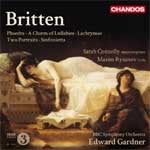Blake, Burns, Robert Greene, Thomas Randolph, John Philip (E)
2.2.2(II=bcl).2-2.0.0.0-harp-strings
Abbreviations (PDF)
Boosey & Hawkes
A Charm of Lullabies was written in December 1947 for the mezzo-soprano Nancy Evans, who had recently taken part in the first productions of The Rape of Lucretia, in which she sang the title role, Albert Herring, in which she took the part of Nancy (appropriately enough), and who would appear again as Polly Peachum in Britten’s version of The Beggar’s Opera a year later. Keen to provide her with a work for her recital programmes, Britten was helped in the choice of texts for A Charm of Lullabies by Evans’ husband Eric Crozier, who had recently written the libretto for Albert Herring. As with the Serenade of 1943, the work brings together an anthology of diverse texts unified by the themes of night and sleep. The work is one of the most genial and uncomplicated of Britten’s song-cycles, though contrast is provided in the more agitated undercurrents of the two central songs, settings of Robert Greene’s ‘Sephestia’s Lullaby’ and Thomas Randolph’s ‘A Charm’.
Reproduced by kind permission of the Britten-Pears Library
Colin Matthews’s orchestration of A Charm of Lullabies was made in 1990. In order to give the work the extra dimension required for an orchestral song-cycle, Matthews has cleverly expanded the original in some places and connected the first three songs, and the last two, scoring the whole for the same instrumentation as Britten’s Suite on English Folk Tunes. The sleep and dream worlds of the original songs, a theme that preoccupied Britten in two of his other cycles, the Serenade and the Nocturne, are preserved in Matthews’s fine arrangement.

Sarah Connolly, mezzo-soprano
BBC Symphony Orchestra / Edward Gardner
Chandos CHAN 10671
Click here to purchase this CD from Amazon

